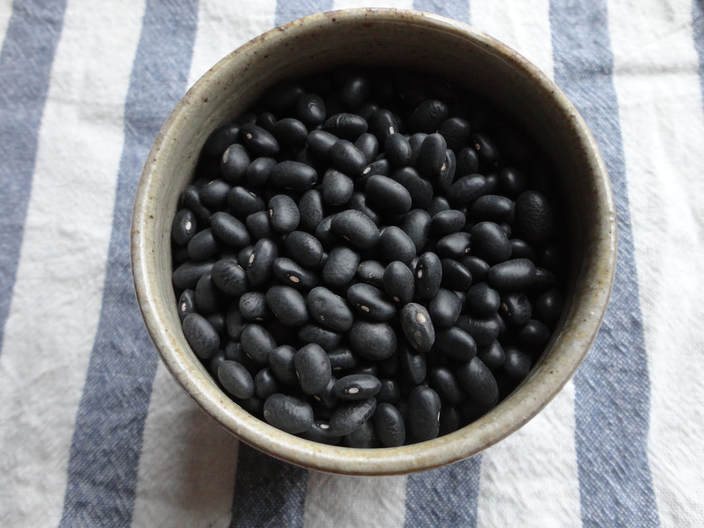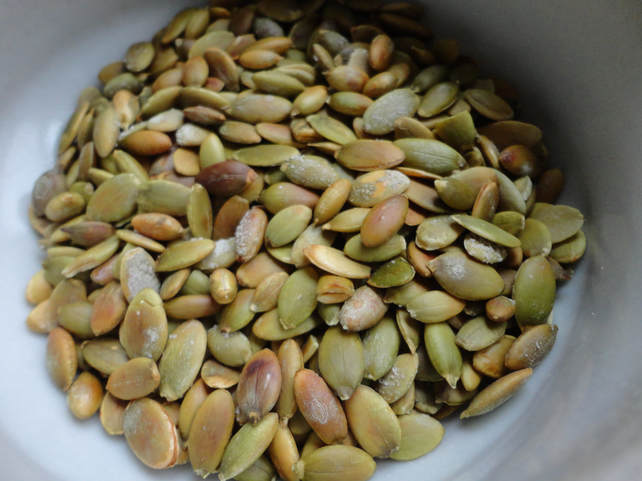|
If you're like me, you have heard your whole life to "eat your vegetables." Unfortunately, in terms of eating healthfully, it is not that simple. Vegetables and other plant foods, including pulses, legumes, nuts, grains and even our beloved greens contain anti-nutrients, naturally-occurring chemicals within the plant that can actually be counterproductive to our health. Now, I'm not saying that eating kale will kill you, or anything close to that. What I am saying is that, if you are striving for optimal health, finding ways to mitigate the anti-nutrient content of your plant foods is very important. There are various diets that tout simply not eating these foods, such as eliminating grains on the paleo diet. One of the reasons these diets eschew some of these foods is their anti-nutrient content. I worry about the popularity of vegan or “plant-based diets” that is growing all over the country, because people are consuming large amounts of vegetables and other plant foods that may be causing inflammation or other health issues, and may not be absorbing all of the nutrients they potentially could be from these foods. Of course, eating a wide variety of foods from plants, in addition to animals, is essential to a well-rounded diet. I think consuming foods from both animals and plants are necessary for good health. One of the issues with the modern diet is that we do not take care to prepare our plant foods properly so that our bodies can digest them well and absorb the nutrients these foods provide. Here I'll tell you about some of the common anti-nutrients found in plant foods, why they are there, and how to reduce their content in your food, so you can get the most benefit from your plant foods. First off, what is an "anti-nutrient"? You have likely heard of all kinds of nutrients before: vitamins, minerals, phytochemicals, and more. But did you know there are substances that are essentially the opposite of all those good things in some of your groceries? An anti-nutrient is a substance that opposes the action of other nutrients and can have an impact on health as a result. They all act in different ways in the body, such as binding minerals, preventing absorption, or creating inflammation. Some actually have beneficial effects in the body, such as tannins that act as an antioxidant, or oligosaccharides that are a prebiotic fiber, but when consumed in large amounts they impact nutrient absorption, and can end up doing more harm than good. This is something to especially watch for when discussing nutrient absorption and availability to those who say plant-based diets are the most healthful; this is simply not true. These are naturally-occurring substances found in plant foods (yes vegans, even plants aren’t always perfect), and are in the plant as a survival mechanism, including defense against predators. Plants are not as passive as some may think; they have the genius of having a built-in defense system to increase their likelihood of survival or even decrease the health of whatever may try to eat it. Dr. Kaayla Daniel, PhD wrote a wonderful, ind-depth article entitled "Plants Bite Back" that you should definitely give a read if you are interested in learning more about anti-nutrients. It has so much good information and plenty of resources for further reading. Here are some of the substances found in plants that we humans regularly consume and the health effects that they can cause. The modern diet that relies heavily on processed foods does not work to decrease the content of these anti-nutrients in foods. In fact, highly processed foods often increase the amounts of these compounds. Traditional diets had the wisdom to prepare their plant foods in ways that would eliminate or decrease the content of anti-nutrients so those who consumed them would be well-nourished and increase their health from eating them. When creating an optimal way of eating in today’s world, we must keep these compounds in mind, and do our best to prepare foods in traditional ways so that we, too, are well fed. Phytates: Also known as phytic acid, this compound is found in beans, seeds, nuts and grains. They are present to help seeds store energy and nutrients, which are important to their survival during dormancy. But, when we eat these seeds instead of plant them, it makes many of the nutrients unavailable to us. Phytates inhibit mineral absorption, especially zinc, calcium, and iron, as well as digestive enzymes that help with breakdown of proteins. This is one of major offenders that make people eschew grains and legumes in paleo diets. However, they are still in high amounts in nuts and seeds that havne't been sprouted, so grain-free foods like almond and coconut flours should be consumed in moderation, just like un-soaked grains. Excessive phytate consumption can cause mineral deficiencies, bone loss, tooth decay, and impaired digestion. Here's a very in-depth look at phytates from the Weston A. Price Foundation. Lectins: Found in beans, seeds, nuts, and grains, lectins are proteins that bind carbohydrates, which are necessary for the survival of these plants. However, they can harm digestion by damaging the lining of the intestines. Lectins have been linked to autoimmune disorders, "leaky" gut and disrupting the balance of flora in the digestive tract. Along with phytates, this is one that I recommend even healthy people be mindful of when thinking of how to best prepare their foods for nutrient absorption and the effect on the GI system. Mark's Daily Apple had a great post about lectins that has even more info on their effects. Saponins: Another anti-nutrient with a link to autoimmune disorders and impaired digestion are saponins. These are found in nightshades, such as tomatoes, peppers, eggplant and white potatoes. Saponins can cause enzyme inhibition and promote inflammation and leaky gut, especially for those who already have compromised digestion. For those without autoimmune or other inflammatory conditions, these are likely not a health issue. Alkaloids: Nightshades are the group of foods highest in alkaloid content. In sensitive individuals, alkaloids can inhibit enzyme activity, create inflammation in the joints and GI tract. Though healthy individuals may not notice any effect, this may create problems for those who already have compromised immune or digestive functions, or experience a lot of inflammation. Salicylates: Found in berries, citrus, nightshades, squash, and other fruits and vegetables, those sensitive to salicylates are those with disorders such as ADHD, autism, arthritis, asthma and more. For those with a salicylate sensitivity, eating foods high in salicylates can cause behavioral or emotional problems, headache, digestive upset, and other inflammatory conditions. Most healthy people, however, can tolerate this anti-nutrient without negative effects. This is a good chart from Everyday with ADHD for a comprehensive list of salicylate contents of various foods. Goitrogens: Found in high amounts in soy products and brassicas (kale, broccoli, cabbage, etc.), these compounds inhibit thyroid function and hormone production. This is especially important for people who already suffer from thyroid disorders; people with healthy thyroid function do not seem to be affected by moderate amounts of goitrogens, as their thyroids can compensate for the small changes in hormone production. However, with the advent of the green smoothie, people are ingesting more goitrogens than may be healthful, so limiting large amounts of brassicas to a few times per week may be prudent to prevent issues with the thyroid. Oxalates: Oxalates, also called oxalic acid, are found in lots of different plants, including soy, chocolate, dark, leafy greens, beets, rhubarb, sweet potatoes, and nuts. They can cause oxidation, leading to inflammation and damage to tissues, including the digestive tract. Those who suffer from kidney stones or other kidney issues are advised to avoid large amounts of foods high in oxalic acid, as they can promote formation and calcification of kidney stones. Also known as oxalic acid, this compound can bind minerals, and care should be taken to minimize their effect for those at risk for iron or calcium deficiencies. People with autism and autoimmune disorders are also often advised to follow a low oxalate diet due to oxalate's ability to disrupt the digestive system. William Shaw, PhD has a great article here with more info on oxalates and health, and Chris Masterjohn, PhD also has several articles regarding health effects of oxalates, including this one. Phytoestrogens: Many people have heard about phytoestrogens, especially in relation to soy products. Phytoestrogens can have a negative impact on female fertility, PCOS (polycystic ovarian syndrome), menstrual regularity, thyroid function, and may even be linked to cancer formation. They resemble natural estrogen at the cellular level and can disrupt hormone balance and pituitary function in the body. Healthy people can tolerate moderate amounts of phytoestrogens; however, women who are already experiencing infertility, hormone imbalance, or PCOS can be very sensitive to their affects. Obviously high in soy, all beans and legumes contain some amount of phytoestrogens, including chick peas, as well as flax seeds and hops. Stefani over at Paleo For Women wrote a great post about phytoestrogens here. Oligosaccharides: These are found in high amounts in beans and grains, these chains of carbohydrates cannot be digested or absorbed by the digestive tract, and can remain in the lower GI tract and ferment there. For people with healthy digestive tracts, this is actually a beneficial fiber, as it acts as a prebiotic that feeds the good bacteria in the gut and improves their populations. However, in those with digestive issues and a microbiome that is out of balance, this can end up creating digestive upset in the form of gas, bloating, pain, and impaired bowel movements. Those who suffer from conditions like IBS may be more sensitive to these, which is why they are advised to avoid these on a low FODMAP diet (the “O” is for oligosaccharides). For those people, removing these for a period of time and then re-introducing them when the microbial balance is restored can be beneficial. Enzyme Inhibitors: These anti-nutrients are found in beans (very high in soybeans), grains, seeds, nuts, nightshades and other fruits and vegetables. They can damage the pancreas, and therefore the whole digestive process, by inhibiting formation of enzymes, such as protease and amylase, that break down proteins. This can have a negative impact on nutrient absorption, growth, immune function, and metabolism. Tannins: Though they are known to have antioxidant properties, as they are polyphenols, tannins can also inhibit nutrient absorption in foods. Found in tea, chocolate, coffee, wine, berries, buckwheat and other various plant foods, these need not be avoided altogether, but limited. Because they do have beneficial properties, getting foods with tannins is still important. However, reducing the amount of tannins through cooking, soaking or fermenting may be beneficial to those who have compromised digestion or other health issues where nutrient absorption needs to be closely monitored. But what can you do about all this? Never eat plants again? No way! This post is NOT intended for anyone to become obsessed about food and taking every possibly offensive food out of their diet. My intention is just to educate you on what may be in our modern diet and how to increase the digestibility and nutrient content of the foods you love. Many of these components are really only issues for those who have health problems like IBS or autoimmune disease, and some of them, like phytic acid, should be watched even in healthy people. However, freaking out about every little anti-nutrient will be just as harmful to your health as the anti-nutrients themselves! As I said previously, I do not believe that containing anti-nutrients makes a food inherently “bad” and that it should be avoided. In my view, it is nature reminding us of the need for traditional food preparation to get the most of our foods. Hope is not lost! Instead of cutting foods out altogether, take action to properly prepare your plant foods. Here are three easy ways to decrease the amount of anti-nutrient content of common foods: Soaking/Sprouting/Souring: Soaking, sprouting or souring grains, nuts, seeds and beans can reduce the amounts of lectins, phytates and oligosaccharides in them, improving their digestibility and helping to prevent them from binding minerals. Phytates and lectins are especially reduced when moisture, warmth, and acidity are present. Soaking any grains or legumes before cooking, sprouting nuts, or making sourdough bread are ways to reduce the anti-nutrient content of these foods. My general guideline for eating grains, legumes and nuts is to always prepare them through soaking or souring, such as making sourdough breads or soaking oatmeal overnight for the most nutrients and least amount of inflammation. Some grains like white rice, or grasses like buckwheat are lower in phytic acid, so I don't always worry about soaking them as much, though I try to when I can. Check out Sally Fallon's timeless book, Nourishing Traditions, check out sourdough bread books like Tartine Bread by Chad Robertson or Sourdough by Sarah Owens, as well as Ramiel Nagel’s Cure Tooth Decay for tips and recipes regarding soaked and sprouted foods, as well as more info on the health effects of grains and legumes that are not properly prepared Fermenting: The process of fermenting introduces lots of beneficial bacteria and enzymes into foods, therefore improving how well you can digest them, and even increasing their nutrient content in many cases. Fermentation also helps reduce anti-nutrients in the food, including goitrogens, saponins, lectins, phytates, oxalates, protease inhibitors, phytoestrogens, and oligosaccharides. For example, only eating soy that has been fermented, such as miso or tempeh, can limit your intake of many of these anti-nutrients. I recommend Sandor Katz's Wild Fermentation and The Art of Fermentation, Fermented: A Four Season Approach to Paleo Probiotic Foods by Jill Ciciarelli, and Fermented Vegetables by Kirsten and Christopher Shockey for recipes and more info on fermenting. Cooking: Raw is not always best, plain and simple. By adding heat to plant foods, such as steaming, baking, or boiling, you can reduce the anti-nutrient content by quite a bit. Not all compounds are affected by heat in the same way. Lectins and phytates are moderately destroyed by heat, but goitrogens, oxalates, alkaloids, protease inhibitors, and possibly saponins can be lessened by a large amount, just by cooking your vegetables before eating them. Vegetables like spinach, kale and cabbage should only be eaten raw on occasion; their nutrients are better absorbed when cooked…I’m looking at you, green smoothies! For nuts and seeds, I recommend always eating them soaked or sprouted and then cooked (toasted, baked, etc.) for the most nutrient absorption. For other vegetables like greens or tomatoes, eating a balance of raw and cooked vegetables will help protect from excessive amounts of anti-nutrients.
Though you need not obsess about every possible facet of the foods you are eating, being more mindful of how traditional cultures would have prepared foods will likely be beneficial to your health. If you have an autoimmune disorder, tooth decay, compromised digestion (leaky gut, gut dysbiosis, candida, etc.), or other inflammatory condition, you may want to limit your consumption of foods with these anti-nutrients in them, particularly when they have not been properly prepared through heat, fermenting, or soaking/souring. If that is your case, you will want to be more cautious when choosing and preparing your foods, especially if you go out to eat. I do not believe that a healthful, therapeutic diet necessarily means whole groups of foods need to be taken out, but seeing a qualified health care practitioner, such as a nutritionist or doctor can help you with these changes. If you are generally healthy, it is still a good idea to properly prepare your plant foods and balance them with plenty of animal fats and proteins, along with adequate vitamin C and minerals. Also, choosing foods that are grown organically will also increase the nutrient content available in these foods in the first place. These strategies will help ensure that you are absorbing all you can from the foods you are eating and minimizing any inflammation or other ill effects from these anti-nutrients. Perhaps certain conditions or symptoms, such as leaky gut, would lead you to focus on eliminating some anti-nutrients over others, so you can focus your energy where it needs to go and reduce anxiety around food. Eliminating unfermented soy, which seems to be high in just about every anti-nutrient, is probably a good bet no matter your health status. Whatever you do, it is important to find out what works best for your body and makes you feel your best. Eating and feeling well does not have to be too complicated and with a little extra planning and preparation, it can be easy and delicious to keep your body nourished
0 Comments
Leave a Reply. |
Brine & Broth
I am a gut health-focused nutritionist and online health coach based in Southwest Wisconsin. My recipes and philosophies center around traditional, nutrient-dense foods that support robust gut health. Archives
May 2022
Categories |









 RSS Feed
RSS Feed
